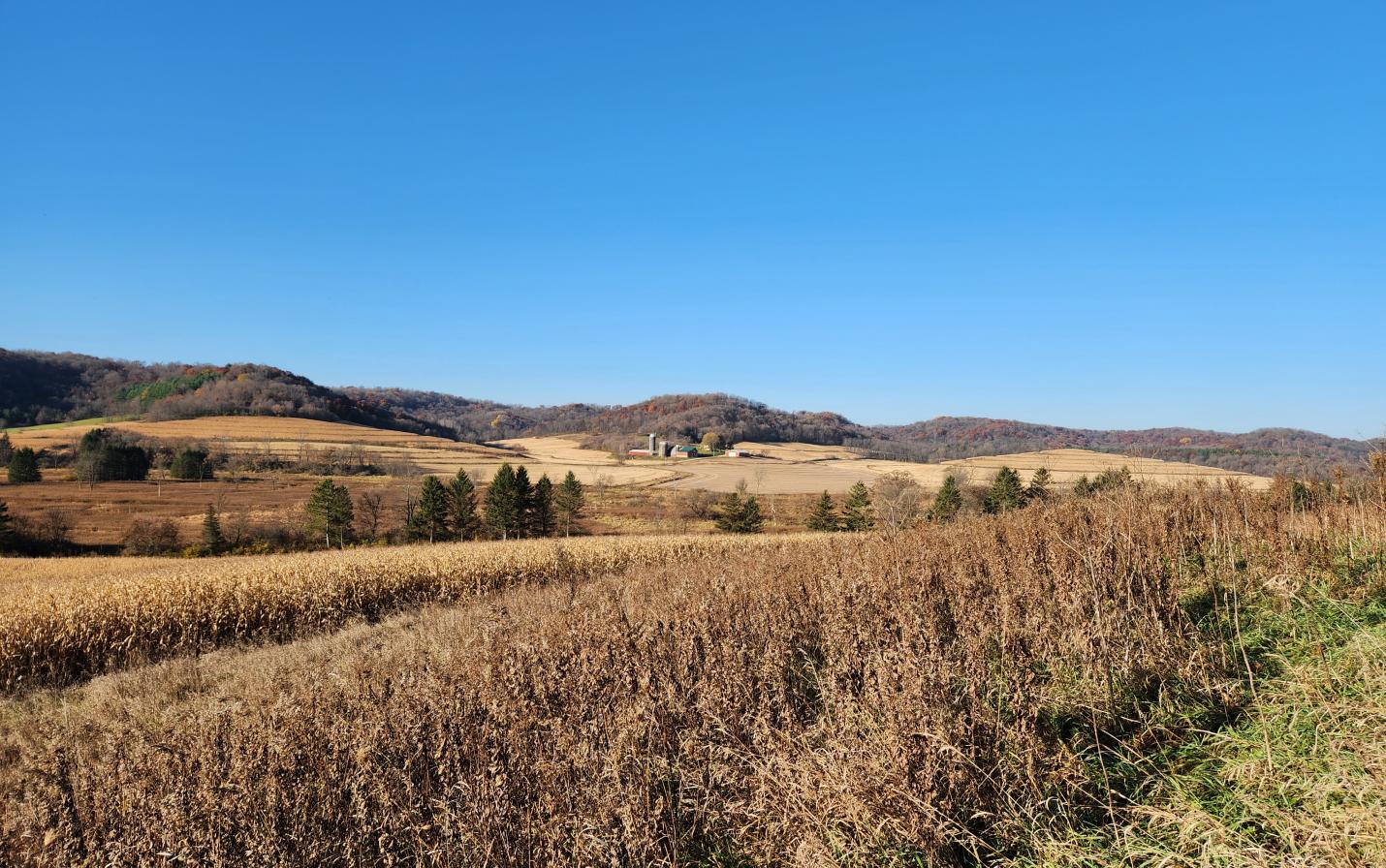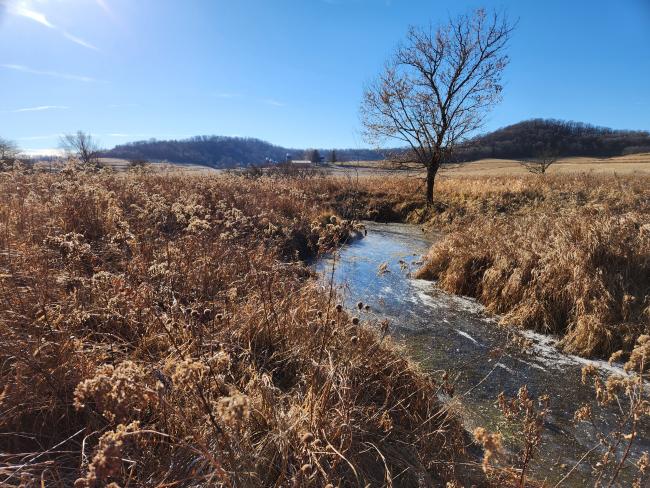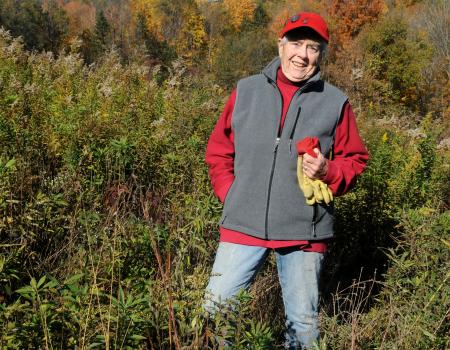
Permanently protected land is largest conservation agreement in Mississippi Valley Conservancy’s 25-year history
LA CROSSE, WI – On a recent tour of her Fancy Creek Llama Farm via her utility terrain vehicle, Marilyn Houck explained the features of this special land and the efforts of generations to conserve it. Accompanied by one journalist and five dogs (a couple of which belong to her sister) that went along for the ride, Marilyn pointed out the woodlands, clear springs, prairie plantings, and Fancy Creek, all of which make up her 993-acre farm north of Richland Center, Wisconsin.
“Both Kent, my late husband, and I agreed; we did not want to see this property developed into acres of housing. I am sure he would be pleased with our agreement with Mississippi Valley Conservancy to conserve the land.”
The property is a land mass of three connecting farms. On the property, Marilyn and late husband, Kent C. Houck, followed the family tradition regarding good agricultural practices and land ownership as they cared for the land and its unique features. Kent’s grandparents, first in the family to acquire the farm in a series of acquisitions, were Dr. Charles and Georgia Bowen who purchased the Mosher farm in the mid-1930s. This was followed by the purchase of another farm, the Lee farm in 1950, directly across Fancy Creek from the Mosher farm, by Kent’s parents, Nelson S. and Alice (Bowen) Houck. The final acquisition of land was in about 1956, when Nelson and Alice Houck, bought the land at the end of the valley. The homestead there got its water by the pailful from the spring at the bottom of the hill just below the house. Fortunately, they had a large family to carry water. Marilyn and Kent shared a happy married life in this house with a couple of additional rooms added.
Marilyn wants to honor Kent, his grandparents, and his parents with conservation of the land for the future. “Their vision and judgment were meant to preserve this land. Without their vision and the opportunity to purchase the land and put together a farm that worked and complied with good agricultural practices, this farm would have been lost to the pressure of housing developments.”
Just as Marilyn and Kent hoped, a recently signed agreement—called a conservation easement—with Mississippi Valley Conservancy will permanently prevent development and mining from harming water and wildlife habitat on the land. The farm remains in Marilyn’s hands, and she will continue to rent out the cropland and pasture, to harvest timber under a management plan, and otherwise inhabit the land as she has in the past. If she wanted to, she could construct buildings in designated building zones. She can also sell or donate the land, but any future owner must abide by the terms of the easement, which is now permanently part of the property’s title.
Regarding her agreement with the Mississippi Valley Conservancy, Marilyn says, “I’m encouraging my neighbors to do the same thing.”
One of Marilyn's favorite parts of the farm is the large spring just down the hill close to her house. She can see it from the kitchen. The spring is noted in plat books as early as 1874, but it has a history that reaches back far before that, as far back as 900 AD, when native peoples inhabited the land. “My husband’s father was interested in this particular piece of property because this spring and others up the valley made this land a perfect place to winter-over livestock,” Marilyn explains. “The family who lived here in the 1950’s cooled the milk from their few milking cows in the runoff from the spring in a small cooling shed called a spring-house.” In 1985, Marilyn's husband, Kent, showed her how to make a siphon in the small pond created by the spring. Every day, since then, using a garden hose, Marilyn and her sister, Judith, have used the siphon to keep the 50-gallon watering tanks full and flowing for the llamas on the farm. Water not used by the llamas just flows back into the stream via relief outlets… the water just continues to run uninhibited, as it travels on its way to Fancy Creek.

Of particular interest to Marilyn has always been what to do about Fancy Creek, nearly a mile of which runs through her farm. Like many streams in the area, it was straightened in 1947 to better drain the land for agricultural use. The result is a ditch that directs water and sediment downstream like a fire-hose, increasing the likelihood of flooding downstream, including on the Pine River through Richland Center. The original streambed is still intact, with oxbows visible. The associated floodplain and wetlands still support considerable native vegetation such as sedges and many other wetland plants.
“As I'd walk the dogs every day the length of our country road,” said Marilyn. “I could see the creek and its potential and always wondered if it could be restored. After all, the old meandering oxbows are there just waiting, with many of them filled with water from many springs in the valley.” In the hope of answering her question of whether or not the creek could be restored, Marilyn put in a call to the Wisconsin Wetland Association, which quickly saw the potential for a watershed-sized restoration that would not only bring back the diversity of the creek and the floodplain function, but also retard water flow to better protect properties downstream.
The partnership soon grew to include the Wisconsin Department of Transportation, Southwest Wisconsin Regional Planning Commission, multiple local and state agencies, university groups, and most important, neighbors, who want to join the effort to restore the creek. With the easement held by Mississippi Valley Conservancy, Marilyn’s part of a restored Fancy Creek will be protected in perpetuity.
“The site will demonstrate the importance of wetland restoration to climate resilience, and the benefit of reconnecting creeks and streams to the surrounding floodplain to mitigate issues of flooding in downstream municipalities,” according to the Conservancy’s Conservation Director Abbie Church.
The Houck farm is scenic and diverse, comprised of working croplands, oak woodlands, pollinator plantings, wetlands, cliffs and sedge meadow.
“This property has everything,” said Church. “While hiking the woods this spring, I heard both black-billed and yellow-billed cuckoos calling.” She said both species are in decline and prefer to nest in large, dense woodland. Their presence on the property during nesting season speaks to the diversity and quality of the woods and riparian areas.
At 993 acres, the Houck farm is the largest conservation agreement to date for Mississippi Valley Conservancy, an accredited nonprofit land trust that serves nine counties of southwest Wisconsin. Like many who create a conservation agreement with the Conservancy, Marilyn wants her protected land to be a legacy, honoring her family and the original owners of the land.
“Kent and his father had a farm plan,” she explains, “and, through the years, we have all used good conservation practices to keep the land stable, including no-till planting and contour farming. Areas of highly erodible soils have been planted with native prairie plants specifically selected to support pollinators and prevent runoff into the creek, and to help keep the farm's forest land growing and productive, it has been in the Managed Forest Program for over 35 years, with the membership in the program having been renewed in 2021 for another 50 years.”
Top photo: The 993-acre Fancy Creek Llama Farm near Richland Center, WI, is permanently protected by Mississippi Valley Conservancy through an agreement with owner Marilyn Houck in honor of her late husband and his parents and grandparents. The creek restoration project will help to protect neighbors and community from flooding during extreme weather. Photo by Abbie Church.
About the author: Drake Hokanson is an author, photographer, editor, largely recovered college professor. Current job title: independent, organic, free-range scholar.
Drake has served several terms on our Board, and he currently serves on our Communications Committee. He and his co-pilot, Carol Kratz, help the Conservancy to monitor conserved land in their small airplane.
